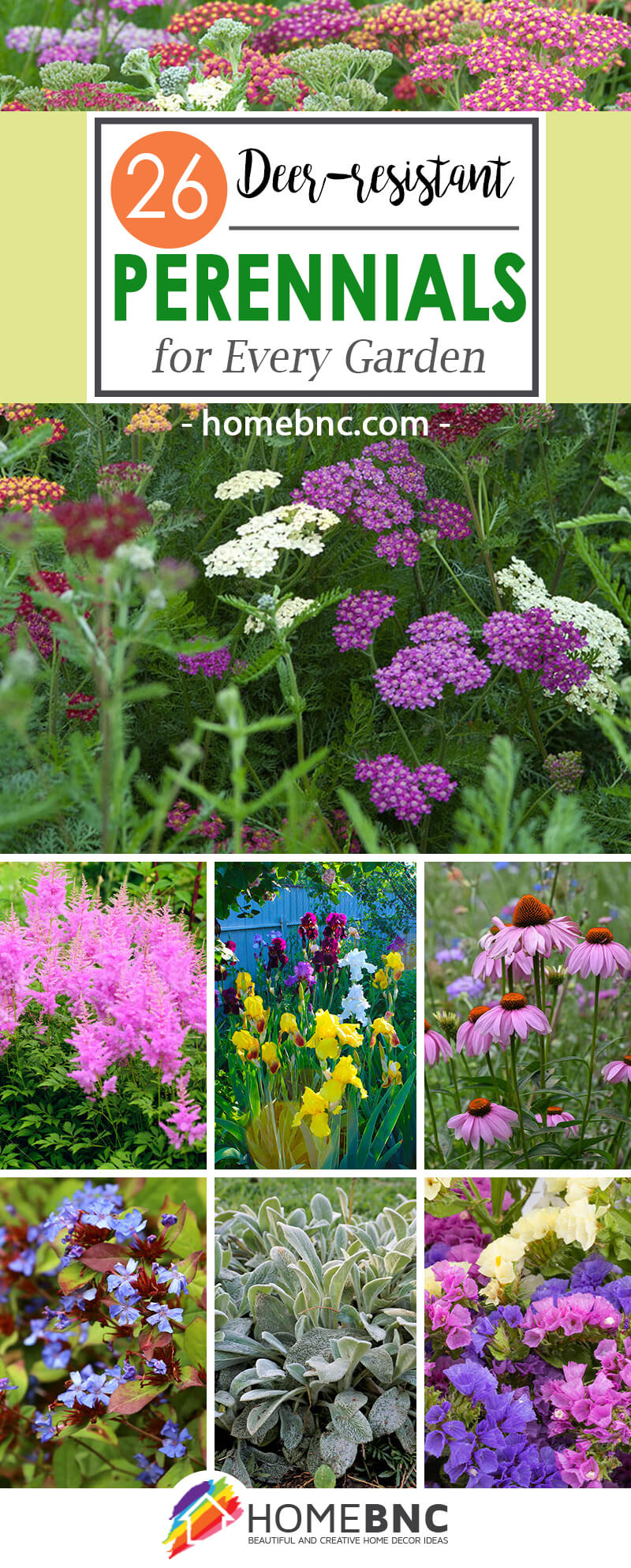Most gardeners would consider it a selling point if a plant “attracts wildlife.” Wildlife – what’s not to like? Songbirds, butterflies, bumblebees… Of course, there’s wildlife and there’s wildlife, and one of the animals you probably don’t want to see in your garden is a deer (or more likely, a whole herd).
If you haven’t lived in a place where deer are abundant, you might think of a deer in your yard as a magic moment – but deer are like that neighbor who is always asking to borrow your Tupperware and never seems to get around to returning it. They may seem harmless at first, but they’re here for your hostas, and they don’t mind coming back when you’re not around. In fact, they can wait all day – they’ve really got nothing else to do.
26 Deer-Resistant Perennials that You’ll Love (But Deer Won’t)
Kidding aside, there’s nothing more frustrating than carefully planning and planting a beautiful garden, only to watch it disappear into the stomachs of hungry deer. The worst part about a deer problem is that it can seem like there’s no solution: you can’t spray for deer, nor can you enlist natural predators (unless you have a pet mountain lion). You can’t even trap them, because they’re so darned big – and getting bigger every day, off of your prized perennials!
However, the situation isn’t as hopeless as you might think. As the old saying goes, a stitch in time saves nine, and it’s as true for deer damage as it is for sewing: the key to keeping your garden un-browsed is to choose plants that won’t get browsed in the first place. Often, that means plants that are strongly scented, armed with thorns and spines, or that are toxic to deer (but be careful with the latter, because they’re often also toxic to pets and even to humans).
There are plenty of misconceptions about “deer-proofing” your garden, starting with the idea that you can do it at all: there really is no such thing as a truly deer-proof plant, because a hungry deer will eventually try almost anything you plant. However, plants have all kinds of traits that make them unattractive to deer, and there are plenty of beautiful perennials that – under most circumstances – are not worth the effort to any but the hungriest deer.
Below, you’ll find 26 perennials that only a deer couldn’t love, from hardy ground covers to showy specimens, and from creeping ground covers to showy specimens. You’re almost certain to find something you love on this list – but if not, you’ll also find tips for making your own deer-resistant picks. With a little thought and some judicious plant selection, you’ll soon be enjoying your garden safe in the knowledge that Bambi isn’t enjoying it, too.
Key Takeaways
- Deer are opportunistic browsers, which means that they generally prefer eating from gardens they consider “low-risk”. In many places, deer consider humans “high-risk,” and human presence may be enough to keep deer away — so plants close to your house, no matter the species, will be safer. Unfortunately, in many areas deer have become habituated to human presence, and this strategy doesn’t work.
- Plants resist damage from deer (and other herbivores) in a number of ways: some contain chemicals that are toxic to herbivores, some are merely unpalatable to them because of their strong smell or flavor, and some have physical characteristics that make it hard for deer to eat them. Some even escape being eaten by dying back to the roots before deer can get to them, and even just by being inconvenient: very low growing plants are harder for deer to reach, so deer ignore them if there’s something taller.
- Strongly-scented plants are great additions to a deer-resistant garden because they actively repel deer. They can even be planted around or among more vulnerable plants as a “smoke screen.” Some plant families are particularly rich in these plants, most notably the mint family (Lamiaceae). When in doubt, take a leaf from a plant and crush it: if you notice a strong smell (especially a sharp or “medicinal” smell), a deer probably will too, and leave it alone.
- Toxic plants would seem to be the most deer-resistant of all, but there are some caveats. If the plant isn’t native, deer won’t recognize it, and may not be able to tell it’s toxic. By the time they get the message, it may be too late. Second of all, these plants are often toxic to pets, too, and even to humans, so gardeners with outdoor pets or young children should be cautious about planting them.
- Some plants aren’t equally resistant to damage at different life stages, and some are only partly deer-resistant: echinacea, for example, has flowers that are too tough and spiny for deer to eat — but they will happily munch echinacea before flowering.
- Very few plants have permanently escaped the danger of deer damage. If deer are really hungry, they will still eat plants that are supposedly “deer-proof.”
- On the other hand, some plants are like candy to deer, and these will be the first to go if you have deer in your area: azaleas, hostas, and tulips are some well-known examples, as well as many plants in the rose family. If you’ve noticed deer damage to your garden, you should avoid planting these unless you can protect them.
- If you see deer in your neighborhood, but haven’t yet suffered much damage, the very best thing you can do is to make sure they don’t become habituated to your presence. This means that you should never feed deer, no matter how tempting it might be. Just like coyotes, bears, and other potentially dangerous wild animals, both they and you will be happier if you don’t try to make friends.
1. Bleeding Heart (Dicentra spectabilis)
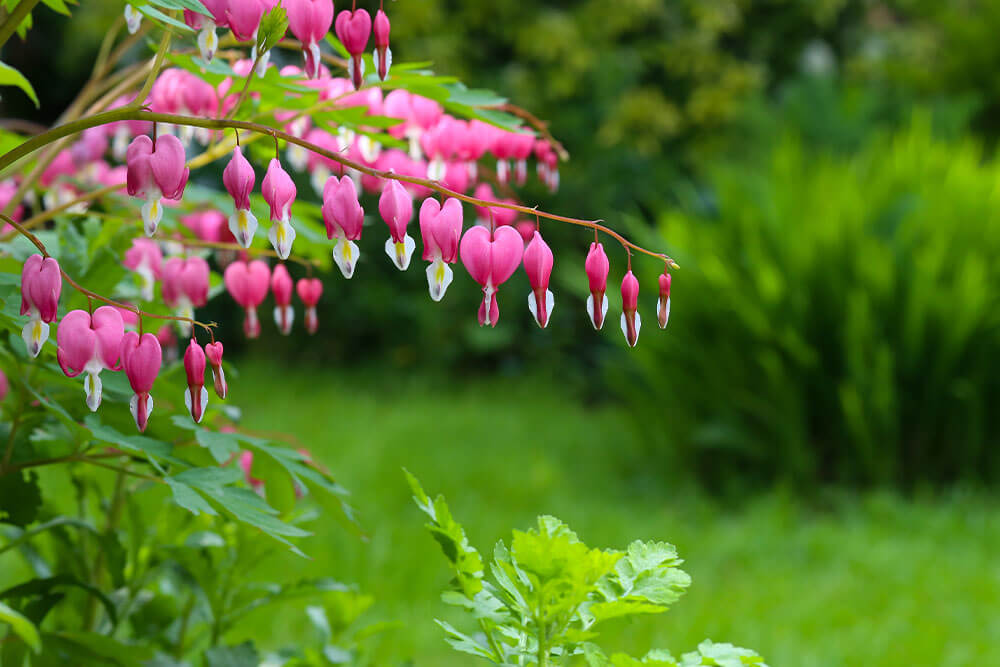
The dainty, pendant pink flowers of bleeding heart really do look like miniature hearts, each with a drop of “blood” formed by the white inner petals. Despite its fairy-tale look, bleeding heart is a surprisingly tough plant: hardy between zones 2 and 8, tolerant of dappled shade, and most importantly, highly deer-resistant.
Although bleeding heart is perennial, it has a rather short season, blooming in early spring and dying back to the roots in summer. (Don’t worry, they’re not dead!) You can stimulate a second flowering by pruning the plants after their first bloom, but you may want to accompany your plantings with summer annuals to fill in the space the plants leave when they go dormant.
2. Astilbe (Astilbe spp.)
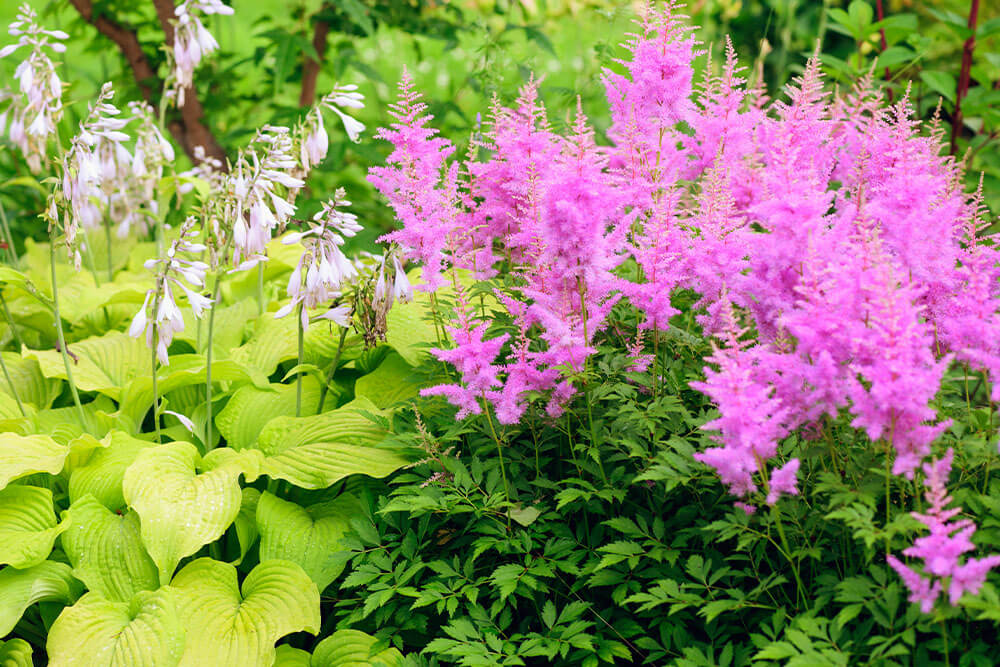
Astilbes are workhorses of the shade garden, sending up luxuriant spikes of pink, white, and purple flowers each summer with very little input, even in deep shade. Astilbes aren’t just another pretty face, however: their fine, compound foliage provides interest long after the flowers have gone, and in some varieties, like ‘Dark Side of the Moon,’ is a deep, dramatic red that exquisitely offsets the bright flowers.
Better yet, astilbes attract all the right kinds of company: bees, butterflies, and other pollinators seem irresistibly drawn to the brightly-colored flowers, while deer (and rabbits and squirrels) give them a wide berth. (There’s no accounting for taste.)
Astilbes can do well in an exceptionally wide range of conditions, depending on the variety – anywhere from zone 9 all the way to zone 3. In northern gardens, these perennials are perfectly at home in full sun, while plants in hotter climates prefer fully shaded locations.
3. Jerusalem Sage (Phlomis fruticosa)
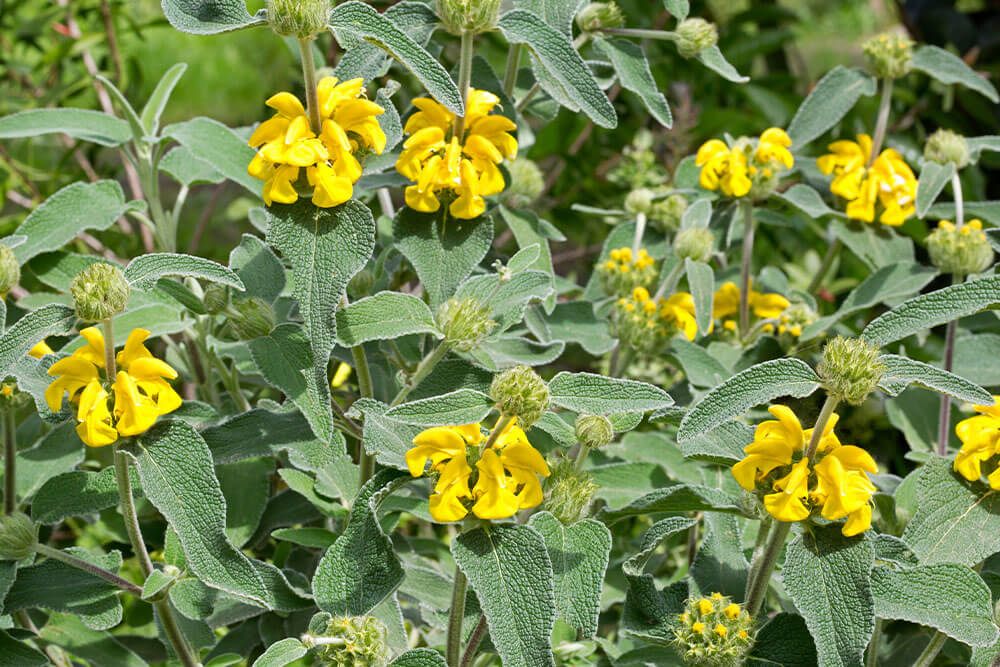
Jerusalem sage isn’t from Israel, and it’s not really a sage (though it is in the same family) – but like Shakespeare’s rose, it would smell as sweet no matter what you called it. Then again, Jerusalem sage’s sweet smell doesn’t come from its yellow flowers (which are odorless) but volatile essential oils in the woolly gray-green foliage. This smell, which is strongest in hot weather, is a great big “warning” sign for deer, who generally won’t come near the plant. (This isn’t the first time you’ll see sage on this list.)
Jerusalem sage is a full-sun perennial, and plants in the shade don’t bloom well and often become leggy. Give it plenty of sun, though, and it can generally take care of itself, adapting to a wide range of soils and moisture regimes. It’s perennial between zones 5 and 10, but will die back to the roots north of zone 8a, while further south it behaves more like an evergreen semi-shrub.
4. Hardy Leadwort, Plumbago (Ceratostigma plumaginoides)
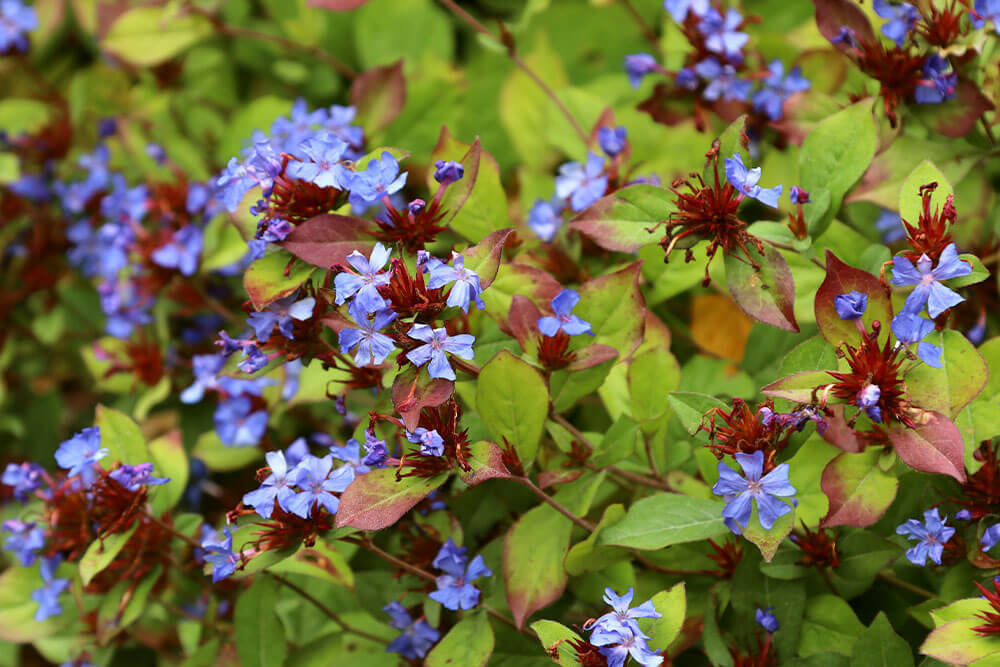
Although it’s often called “plumbago” by gardeners, hardy leadwort – sometimes called leadwood – isn’t that closely related to true plumbagos. Then again, once its blue flowers bloom in mid-summer it’s easy to see the resemblance (even its scientific name is Latin for “resembling Plumbago”). You’ll have plenty of time to notice, not just because the flowers last well into autumn but because there are so many of them: unlike its shrubbier namesake, hardy leadwort is a mat-forming plant.
This makes it an excellent choice for a groundcover or underplanting – and true to its name, an impressively hardy one. Not only does it repel deer, it’s even self-weeding: natural chemicals secreted by the roots inhibit other plants’ seeds from germinating. That said, hardy leadwort can get a little weedy itself under ideal growing conditions, so monitor your plantings for attempted escapees.
5. Peonies (Paeonia spp.)
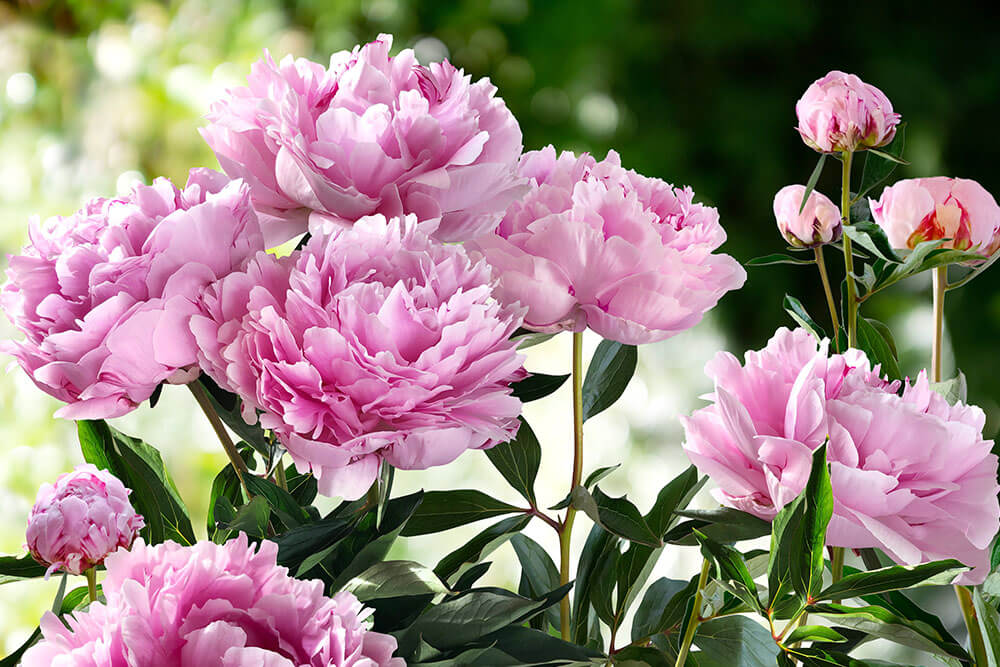
Perhaps no other plant justifies its place in the garden more fully, and in less time, than the peony. It’s notoriously slow to bloom (new plants may take three or four years to produce flowers), and once it does, the show seems to end before it’s even begun: at best, the flowers might last a week, and that’s assuming they don’t collapse under their own weight.
But if you’ve ever grown peonies, you know that for the brief duration of the flowers, none of that matters: their gigantic, fragrant blooms are without peer among ornamentals, and come in an incredible range of colors, from classic pink to sky blue to nearly black.
While humans love peonies, deer do not, and peonies are often recommended as deer-proof ornamentals. And not just deer-proof: frost hardy to zone 2, they not only tolerate cold winters – as low as -50°F! – but actually need them to flower. Even though the flowers in question are heartbreakingly short-lived, the plants themselves are not, and it’s not uncommon for peonies to bloom for fifty or even a hundred years.(To maximize your peonies’ bloom time, plant early-blooming and late-blooming varieties together: if you’re lucky, you can get up to 6 weeks of blooms out of them in this way.)
6.Seaside Goldenrod (Solidago sempervirens)
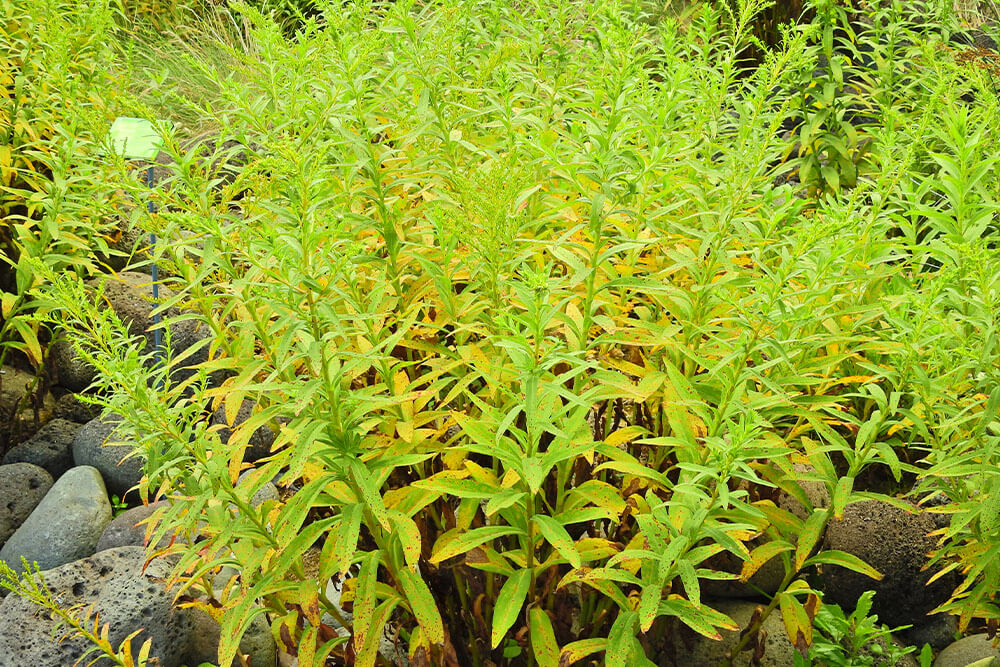
While spring may be the “main event” for flowers, adding some fall-blooming perennials to your plantings can take your garden from a “one-season wonder” to a year-round work of art. And when it comes to late bloomers, you couldn’t do much better than goldenrods. Their small (but profuse) golden flowers aren’t just attractive: they’re a critical source of nectar for butterflies, including the endangered Monarch butterfly.
Most goldenrods are deer-resistant to some extent, but seaside goldenrod is especially so. As you might have guessed from the name, it also has a high tolerance for salt spray, but beachfront property certainly isn’t the only place it will grow. It’s adaptable to a wide range of conditions, including frost (between zones 3 and 8), drought, and low-fertility soils. Seaside goldenrod is also one of the better-behaved goldenrods in gardens: since it doesn’t spread by underground rhizomes, you don’t have to worry about your plants getting out of control.
7. Irises (Iris spp.)
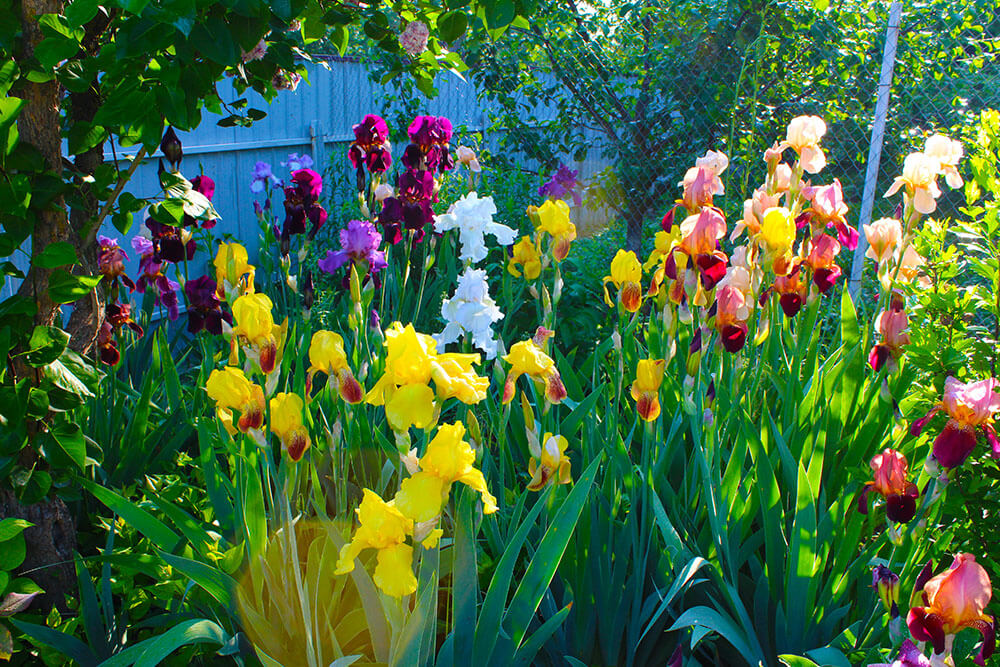
When it comes to bulbs, it’s hard to beat irises for beauty and reliability. (Technically, irises aren’t bulbs, but they look and act a lot like them.) In fact, they’re some of the most popular perennials, period – and deservedly so: with hundreds of species and thousands of unique cultivars available, there’s an iris for every garden, from boggy shade to full sun. The ruffled blue and purple blooms of the massively popular bearded iris (Iris x germanica) are iconic, but there’s a reason these plants are named for the Greek word for “rainbow”: irises come in every imaginable color, shape, and size, and about the only thing they have in common is that they’re all gorgeous.
Scratch that – irises do have one more thing in common: they’re practically deer-proof. Apart from their fragrant blooms (which deer don’t like), irises also contain compounds that are mildly toxic. These chemicals can also irritate your skin, so it’s best to wear gloves when handling the “bulbs.”
8. Virginia Bluebells (Mertensia virginica)

Virginia bluebells are lovely (albeit ephemeral), shade-tolerant perennials, native to forests and river valleys of the eastern United States. Their funnel-shaped blue or purple flowers bloom early in spring, and make them look a little like miniature lilies (though they’re not closely related). By June, the plants will set seed, and quickly die back to the roots. Don’t panic: the roots are still alive, and will bloom even more vigorously the following spring!
This strategy of “hibernating” through hot, dry summers allows bluebells to grow in a wide range of climates between zones 3 and 9, and also helps protect them from damage by deer (after all, you can’t eat what you can’t see). They work best when mixed with other shade-loving plants like hostas and ferns, which emerge later in spring: if timed well, the bluebells bloom early and make way for longer-lasting companion plants.
9. Persian Buttercups (Ranunculus spp.)
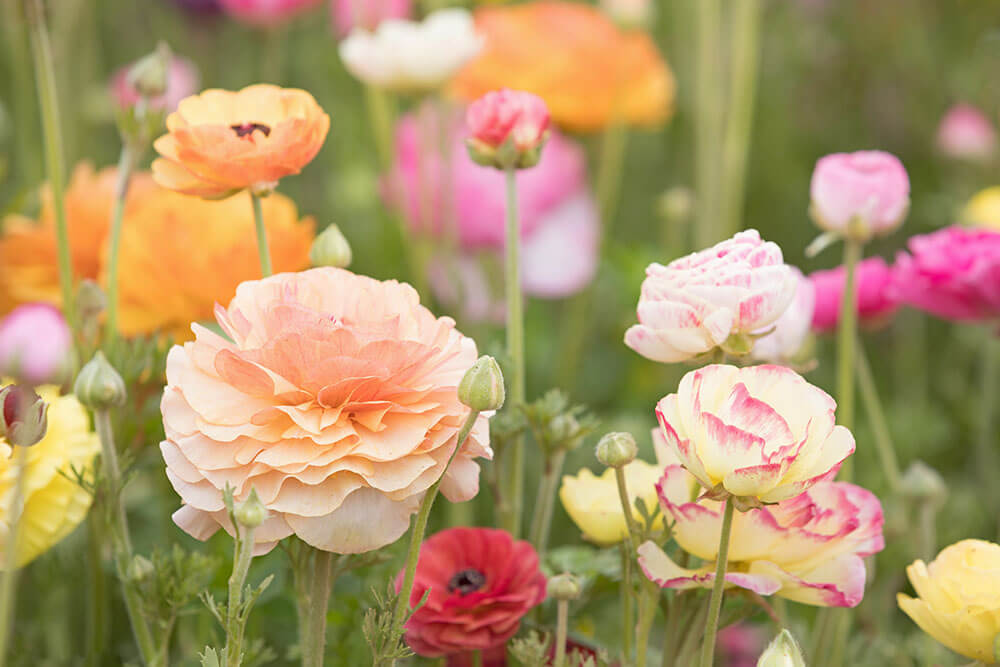
Persian buttercups aren’t true bulbs, botanically speaking, but they act a lot like them: they’re propagated from dried root fragments, planted in the fall, and bloom extravagantly in spring. They integrate well with bulbs, too, but their intricately layered, multicolored flowers look more like roses than lilies. Even after the blooms — which often last for a month or longer — fade, their lacy foliage retains interest well into autumn. Unfortunately for northern gardeners, they are only truly perennial south of zone 7 — but they can be grown as annuals almost anywhere, and make excellent container plants too!
Persian buttercups, like all of the nearly 2,000 species in its genus, are highly toxic, not just to deer, but to pretty much everything else, too. This makes them great for gardeners with a deer problem, but you may want to think twice if you have young children or curious pets.
10. Maltese Cross (Lychnis chalcedonica)
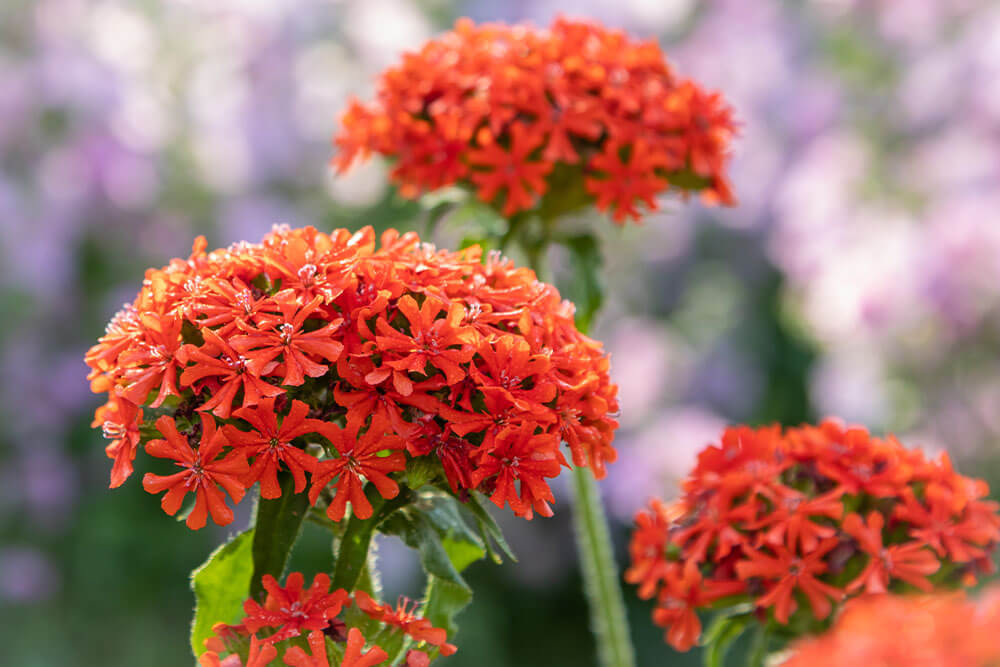
Maltese cross isn’t quite a household name in nurseries, but it’s a lovely and low-maintenance summer-blooming perennial that is both deer- and rabbit-resistant. It gets its name from the unique V-shaped petals of its flowers, which are a rich scarlet (some varieties have pink or white blooms) and come in large clusters that resemble the inflorescences of Queen Anne’s lace. They’re quite long-lived, but the flowering season can be extended even more by deadheading spent flowers, and under good conditions can last from early summer to fall.
Maltese cross likes fertile soil and direct sunlight for at least half the day, but is otherwise quite adaptable to different locations and growing conditions. It has no serious pests or diseases, handles drought well, and is hardy between zones 3 and 8. If grown on very fertile soils, plants have the tendency to grow so tall that they droop under the weight of their flowers, and you may have to stake them to keep them upright.
11. Lamb’s Ear (Stachys byzantina)
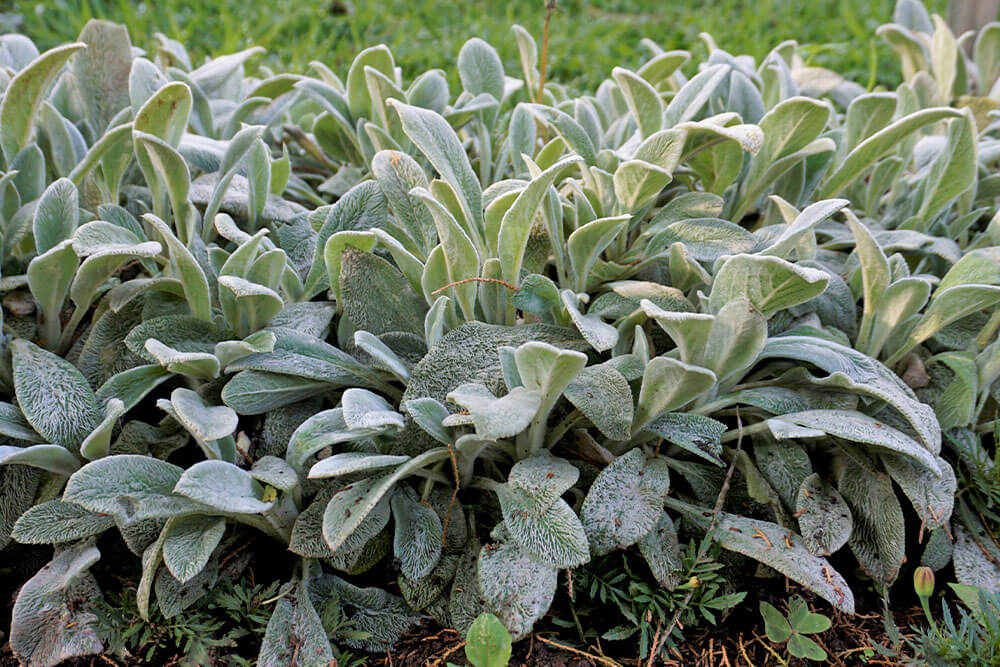
The velvety, silver-gray leaves of lamb’s ear certainly justify the plant’s name, and its spreading growth makes a beautiful border or ground cover – especially in locations where deer eat everything else. The fine hairs on the leaves that give them their color also make them unpalatable to deer, and being in the mint family, its deer-proof pedigree is unimpeachable.
Lamb’s ear is a hardy, resilient plant, but there’s one thing it can’t handle: moisture. The leaves trap dew, rain, and humidity, and if they don’t have the chance to dry out, they’ll develop unsightly spots and may even rot. It’s happiest in dry climates, but will generally do fine as long as it gets plenty of sun, especially in the morning.
12. Ligularia (Ligularia spp.)
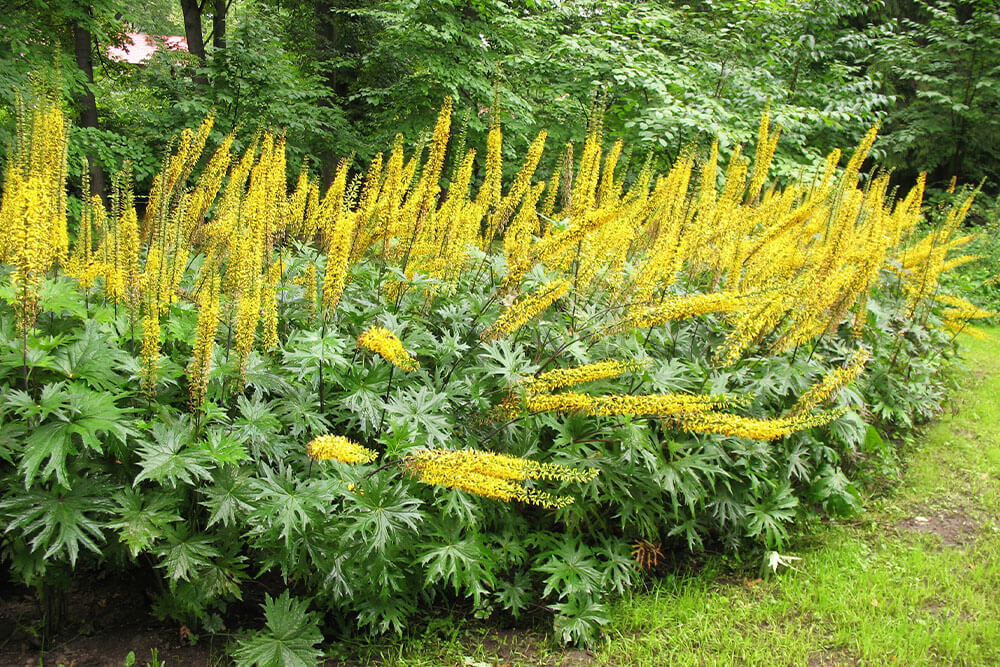
Although they’re part of the sunflower family, there’s nothing especially “sunny” about ligularias, apart from the golden yellow color of their gigantic flower spikes (which can reach five feet tall!). They’re true shade superstars, thriving in cool, damp soils between zones 4 and 8. Their huge leaves – well over a foot in diameter in some varieties – look like they would be candy to a hungry deer, yet they don’t touch them! (Snails and slugs do, however.)
Ligularias have a reputation as being hard to grow, but this isn’t the whole truth: what they are is picky about where they’re planted.
They’ll do best in a location that gets some direct sunlight in the morning, but is shaded in the afternoon. Most of all, they need plenty of water to keep their leaves from wilting. With enough water, and some protection from the summer sun, you’ll be able to enjoy their lush foliage and vibrant blooms year after year.
13. Violets (Viola spp.)

Violets make up a huge genus (Viola) of tiny plants: well over 500, including dozens of hardy natives as well as more exotic varieties like pansies. Most have blue or purple flowers, but this isn’t a rule; the flowers of the heart’s ease violet (Viola tricolor) are blue, white, and yellow. Violets spread freely by underground stems called rhizomes, as well as self-seeding prolifically. This makes them useful as groundcover for shaded borders, and they’ll adapt readily to most garden situations.
While deer disdain them for their short stature and unpleasant flavor, other wildlife absolutely love them: at a time when few other flowers are blooming, violets are an important nectar source for bees, butterflies, and other pollinators. Like some other low-growing, creeping perennials, violets have a tendency to spread, so make sure you can either contain them, or give them enough space to stretch out.
14. Ornamental Onion (Allium oreophilum)
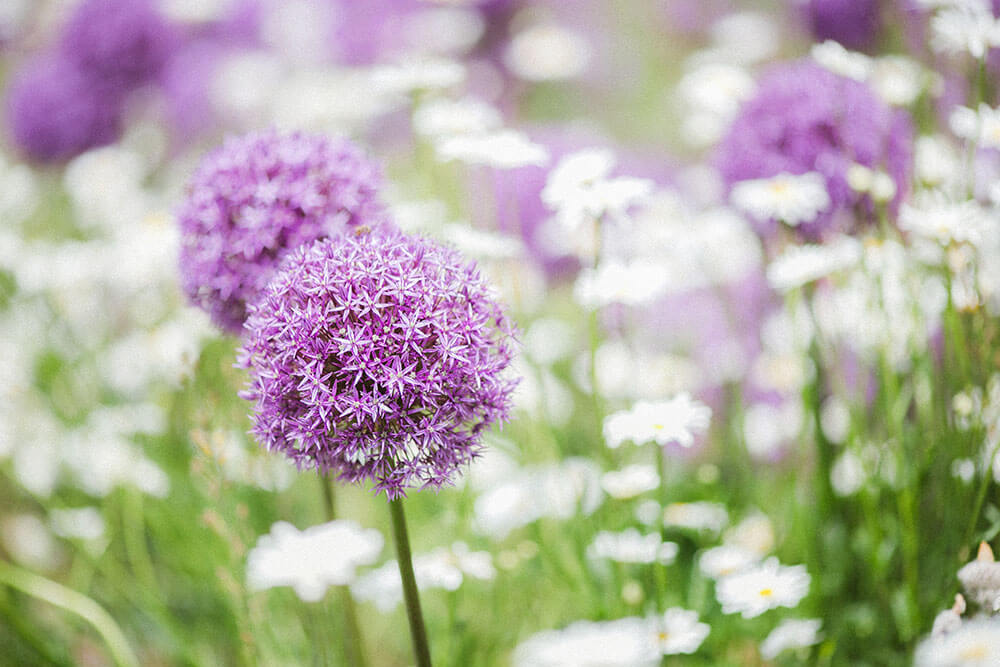
If you’ve ever grown onions, you probably know that they’re not just delicious but beautiful (and big) plants, well worth growing just for their looks. The garden onion’s diminutive cousin, the ornamental onion, is similar in shape but a fraction of the size, and its showy pink inflorescences make it look a bit like a miniature amaryllis (they’re in the same family). It’s hardy between zones 4 and 9.
Ornamental onions are toxic to deer, so they’re some of the most deer-resistant bulbs around (rabbits too). This is true for many plants in the genus Allium, which includes not only a number of tasty edible species but.
15. Yarrow (Achillea millefolium)
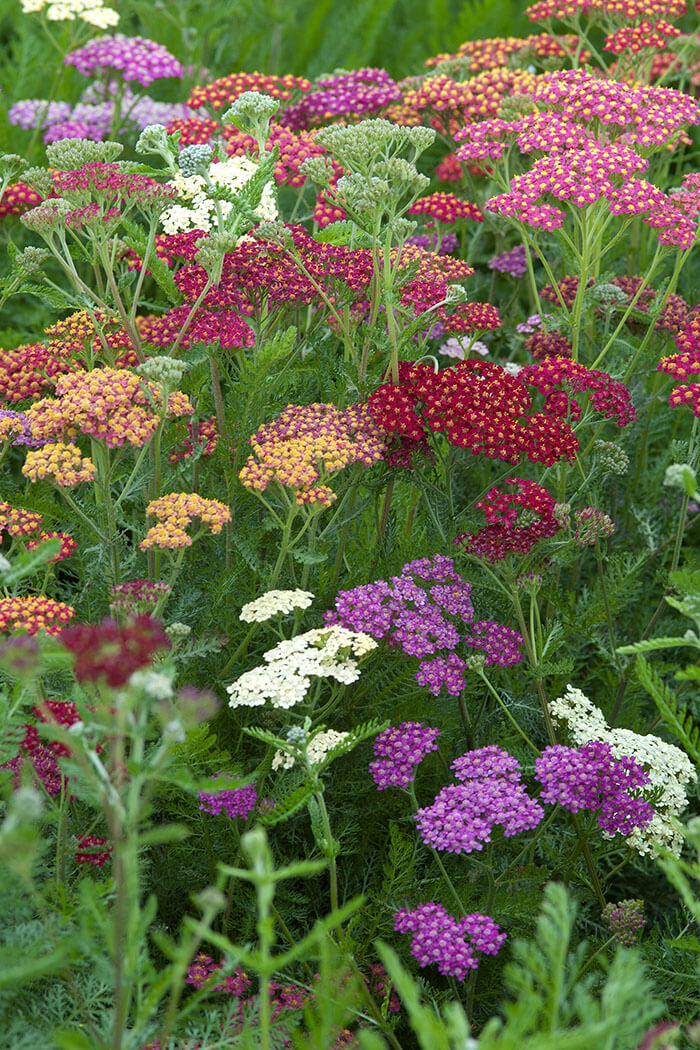
Yarrow has been used for thousands of years as a medicinal plant, but it also makes a lovely, long-lasting ornamental. Its fine, fern-like foliage and dainty flowers – which are amazingly long-lasting – give it a delicate appearance that’s very much at odds with its fighting spirit: this is one tough plant, and will thrive pretty much anywhere. The volatile oils in the leaves that give the plants their medicinal properties also make them extremely unpalatable to deer.
Wild yarrow mostly has white flowers, but gardeners have a much wider range of choices: red, purple, pink, and yellow – and in some varieties, all on the same plants! Once the plants bloom, they will often last all summer, but you can clip the stems (which make lovely bouquets, even after they’ve dried) to encourage a second flush.
16. Yellow Wax Bells (Kirengeshoma palmata)
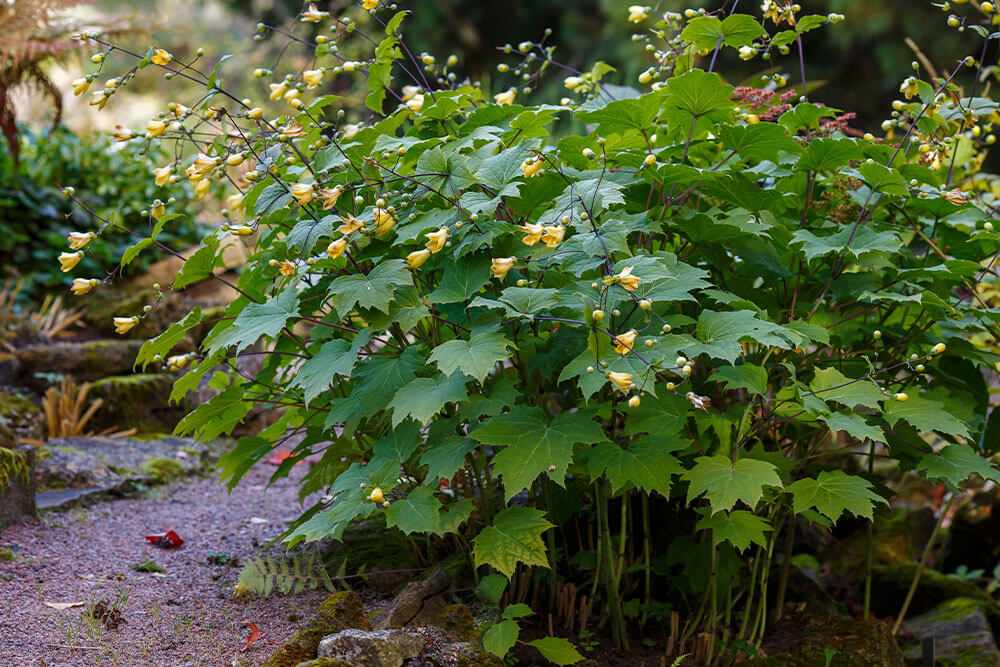
Yellow wax bells certainly earn their name, and the creamy yellow flowers they produce in late summer are lovely, if small, but they’re not the star of the show. That would be the huge, lush foliage, similar in overall shape to maple leaves but much larger. Yellow wax bells look very much like the thirsty, shade-loving plants they are, and in spring and summer they make a lovely background planting for a semi-naturalized shade or woodland garden. In some areas, they’ll even change color before dropping!
Usually, big, luscious leaves are not a good predictor of deer resistance — quite the contrary, as you might imagine. However, deer just don’t seem to like yellow wax bells, and mostly avoid the plant.
17. Tickseed (Coreopsis spp.)
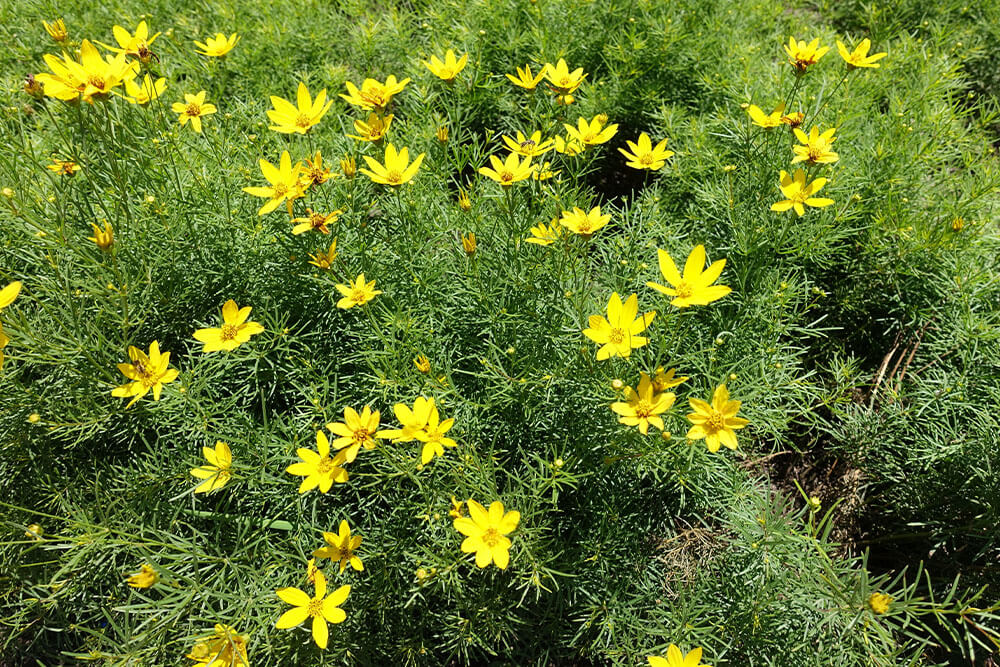
Tickseeds are a genus of around 50 species of hardy, attractive daisies that grow wild all over the country. The annual plains coreopsis (C. tinctoria) is beloved by Southern gardeners for its ease of cultivation, its resistance to deer browsing, and its showy flowers — but there are many popular perennial species as well. All of them are easygoing, deer-resistant summer bloomers, with long-lasting and showy yellow flowers that look even more beautiful when they’re massed in borders or among other asters.
Most perennial tickseeds are surprisingly frost-hardy, but they really shine in warmer areas, where they stand up to drought and heat that would make most other flowers wilt. They also thrive in rocky, infertile soils, and in fact they have the tendency to spread uncontrollably when planted on very rich or moist soil. Deadheading is recommended for tickseed, not just to stimulate additional flowers but because the plants self-seed so prolifically that they can become a nuisance if left unmanaged.
18. Hardy Cyclamen (Cyclamen hederifolium)
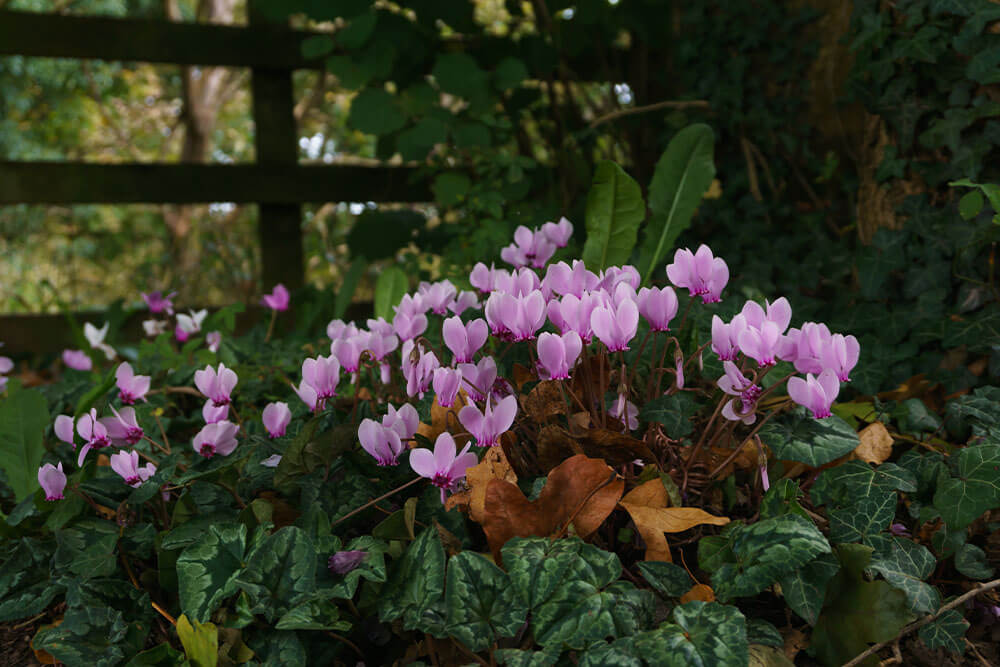
Winter isn’t usually a very interesting season for most gardens. At best, you might enjoy some early-blooming flowers, or some evergreen shrubs and perennials, while you wait for spring to come. Cyclamens, however, completely flip the customary seasonal script: they leaf out in autumn, bloom in the dead of winter, and die back in the spring. This upside-down seasonal cycle isn’t the only unusual thing about these plants: their flowers, which hang from slender stalks just a few inches above the ground, are almost unbelievable, with backward-facing petals that give them an uncanny resemblance to pink and purple moths in flight.
As you might expect of such an exceptional plant, cyclamens are notorious for being difficult to grow — but this is only really true of the most common ornamental variety, the florist’s cyclamen. Hardy cyclamen, on the other hand, is surprisingly tolerant, hardy to zone 5 and requiring only well-drained soil and dappled shade to protect the tender flowers. Hardy cyclamens die back to the roots in spring, but this is actually a useful trait, as it allows them to be interplanted with more conventional perennials that emerge in spring: the two plants won’t compete with each other, and the large, glossy foliage of the cyclamens fills the empty spaces left by plants that die back in the fall.
19. Butterfly Weed (Asclepias tuberosa)
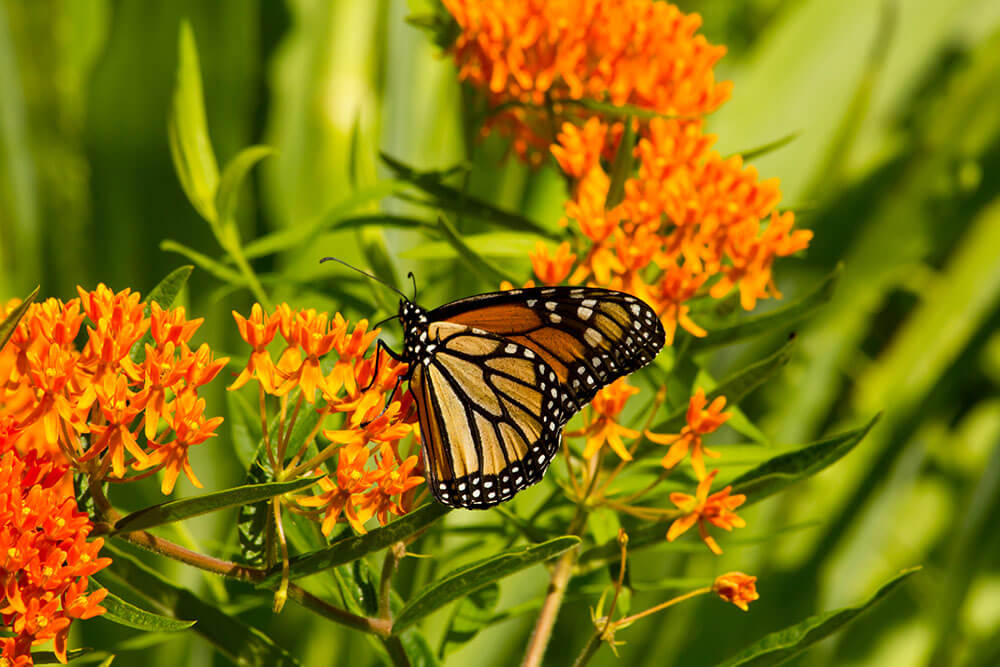
Butterfly weed is aptly named: it’s a host plant for the endangered Monarch butterfly, and its clusters of unusually shaped (but quite beautiful) flowers will attract pretty much every fluttering pollinator for miles around. As a member of the milkweed family, butterfly weed’s “deer resistant” credentials are well-established: like all milkweeds, it contains toxins that are mildly toxic and quite bitter. (Monarch caterpillars absorb these toxins as they eat the host plants, using them as a kind of borrowed protection.)
The “weed” part of butterfly weed’s name is also fairly accurate: it’s easy to propagate from seed, frost-hardy to zone 3, and tolerates drought, poor soils, and even salt spray. However, if you do start your plants from seed, keep in mind that they generally do not flower for two to three years after sprouting.
20. Hyssop (Hyssopus officinalis)
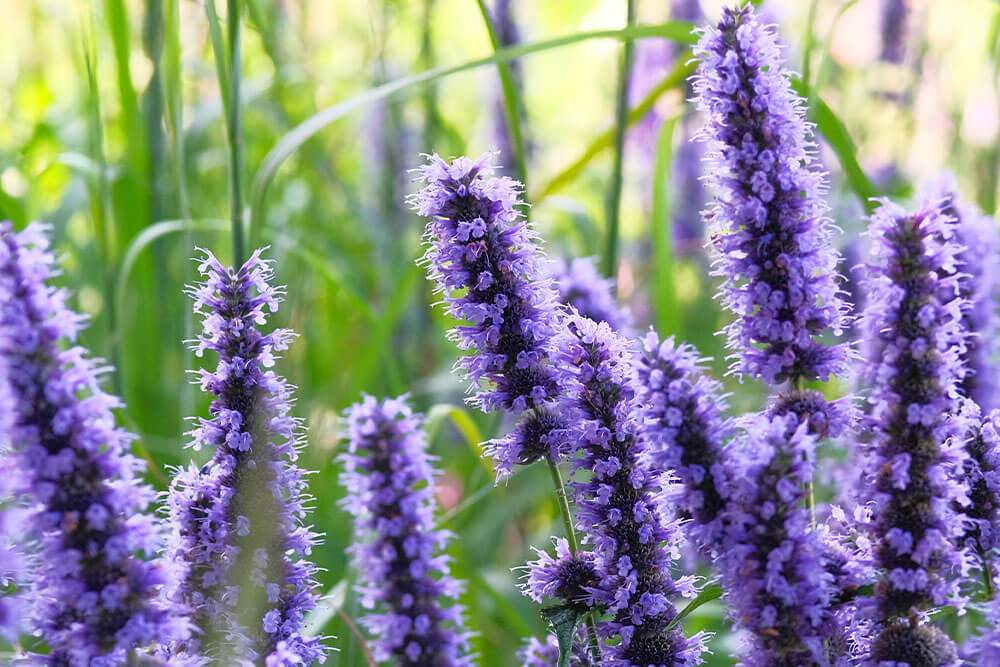
Hyssop’s purple flowers will probably remind you of lavender at first glance, and that’s not a coincidence: both lavender and hyssop are in the mint family, Lamiaceae, which includes a whole host of aromatic plants, including sage, basil, and rosemary. Hyssop isn’t quite as well-known as these herb superstars, but it’s a lovely, fragrant perennial that’s quite hardy, too.
Like many plants in its family, hyssop is remarkably resistant to damage by deer and other herbivores, thanks to the volatile oils in its leaves that give them their distinctive smell. It’s also extremely easy to grow: not only does it self-seed readily, but it can be propagated from stem cuttings or division as well. It’s also cold-hardy between zones 4 & 9, making it a good substitute for lavender in gardens with harsher winters.
Hyssop should not be confused with anise hyssop (Agastache foeniculum), an unrelated native wildflower with a strikingly similar appearance. Although not a true hyssop, anise hyssop is also an attractive, deer-resistant perennial, so feel free to grow either one!
21. Dusty Miller, Silver Mound (Artemisia stelleriana)
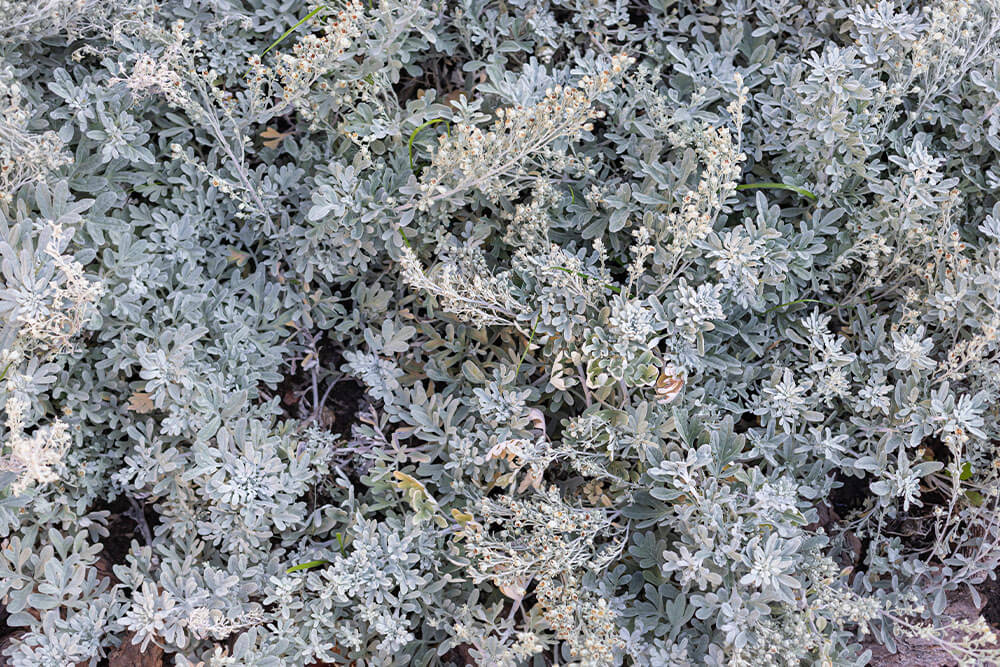
Dusty miller’s silvery, ornate foliage is an elegant addition to any garden, and performs particularly well in borders or as ground cover due to its ability to spread via rhizomes. It’s definitely a full-sun plant, and loves hot, dry, exposed locations where no other plants seem to be able to hang on. (The silver color of its leaves comes from tiny hairs that reflect light and reduce evaporation and heat stress.) It also handles salt spray admirably, which has made it a popular plant of seaside gardens all across the country.
Deer avoid dusty miller both because of its unpalatable texture and the volatile chemicals in its foliage, which has a pleasant aroma similar to sagebrush (A. tridentata). Incidentally, this is also true of Jacobaea maritima, an unrelated plant that’s also often called dusty miller. The two plants aren’t closely related, but they’re both hardy, deer-resistant perennials that can grow well in coastal areas. The main difference is that J. maritima is only perennial between zones 7 and 10, while A. stelleriana is hardy from zone 3 to 9.
22. Statice, Sea Lavender (Limonium spp.)
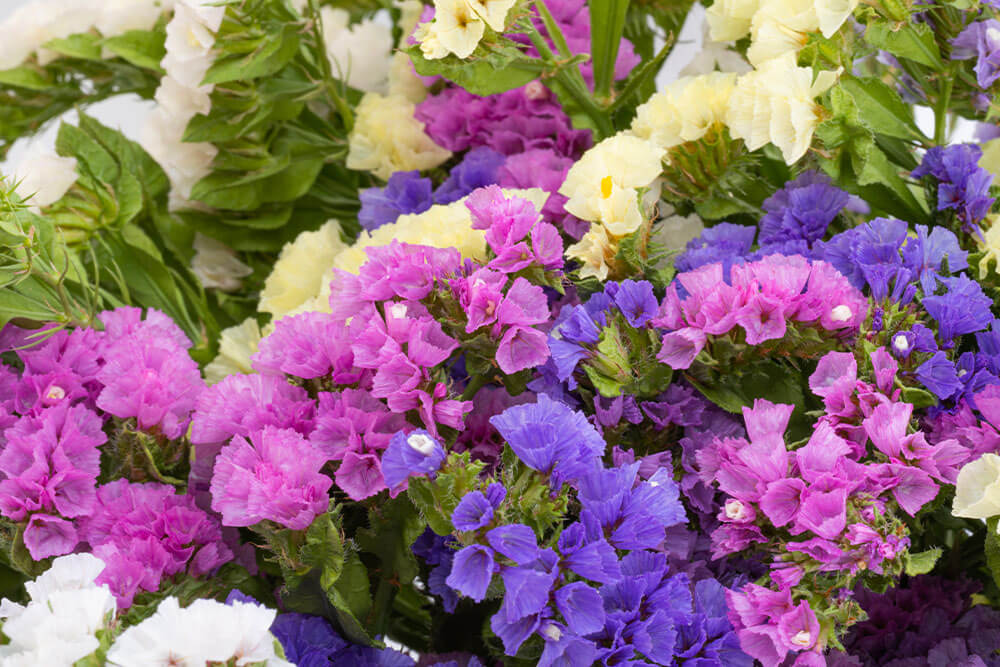
The funnel-shaped, papery flowers of statice are beloved for their vibrant colors, which look as vibrant dried as they do fresh – but attract hummingbirds, butterflies, and native bees when left on the plant. While small, they are so vibrant that they give the plant an outsized place in the garden, contrasting beautifully with their delicate, branching stems.
Native to the Mediterranean, statice has a Mediterranean plant’s tolerance for drought and sea spray, and it’s a great plant for coastal gardens because of its susceptibility to frost. While a number of species are available with varying frost hardiness, most cannot overwinter north of zone 8. The one exception is L. platyphyllum, commonly called sea lavender, which is hardy between zones 3 and 9.
23. Russian Sage (Salvia yangii)
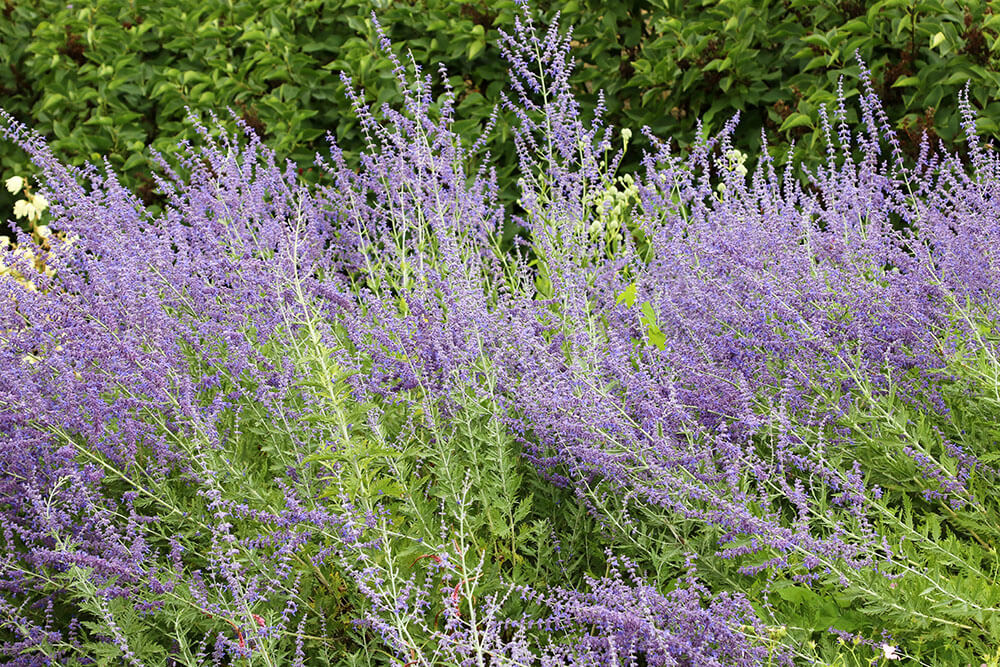
Almost all species of sage are deer-resistant to some extent, as they contain volatile oils that deer find unpalatable. Russian sage certainly has this in common with other ornamental sages (it’s also rabbit-resistant) – but it also boasts exceptionally showy blue flowers, which emerge on long spikes near the end of summer and last well into autumn. These, as well as its ease of cultivation, have earned it the Royal Horticultural Society’s “Perennial Plant of the Year.”
Russian sage handles drought remarkably well, as well as poor soil, urban air pollution, and salt. Unfortunately, and perhaps surprisingly given its name (it isn’t really from Russia), it doesn’t tolerate cold temperatures particularly well, and is only hardy between zones 5 and 9. Within this range, though it’s a.
24. Purple Coneflower (Echinacea purpurea)
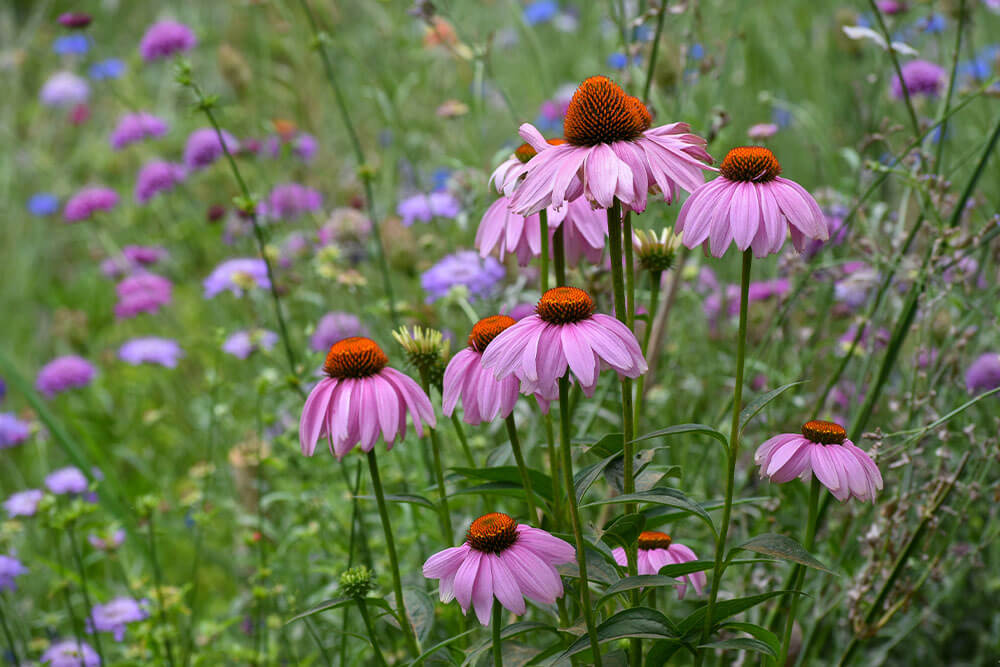
If you’ve ever done a web search for “beginner garden plants,” you’re probably familiar with purple coneflower, or echinacea. When it comes to low-stress perennials (that don’t skimp on color), it really can’t be beat; it’s a real “set it and forget it” kind of plant, and can adapt to almost any environment, whether hot and humid or dry and cold. You don’t even have to deadhead spent flowers: they’ll bloom and rebloom all summer long.
Echinacea isn’t just figuratively tough, it’s literally tough too – so tough that deer won’t come near it, although bees and butterflies flock to it in the summer, and songbirds eat the seeds in autumn. And if purple isn’t your thing, don’t worry: there are red, yellow, orange, and white varieties as well.
25. Oriental Poppy (Papaver orientale)
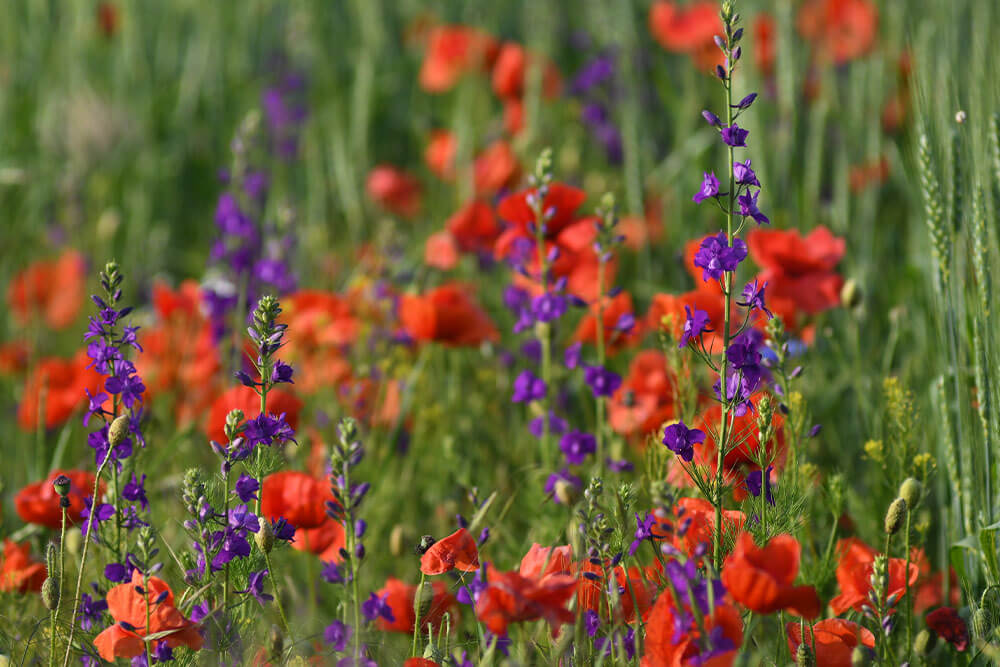
Oriental poppies look a lot like the more common opium poppies, with one big difference: they’re clump-forming perennials rather than short-lived annuals. Like their annual cousins, oriental poppies are deer-resistant, containing similar (though not the same) alkaloids as opium poppies. They also bloom in summer — which can lend some seasonal balance to your garden if it’s heavy on spring-blooming plants — and come in a wide range of colors beyond the classic red.
Unfortunately, oriental poppies are only perennial from the soil down: they die back to the roots in late summer, although they soon grow back as rosettes,which last throughout the fall and winter. This makes them harder to replace than spring-blooming annuals, so they’re best when interspersed with other perennials that will cover for them until the following spring.
26. St. John’s Wort (Hypericum perforatum)
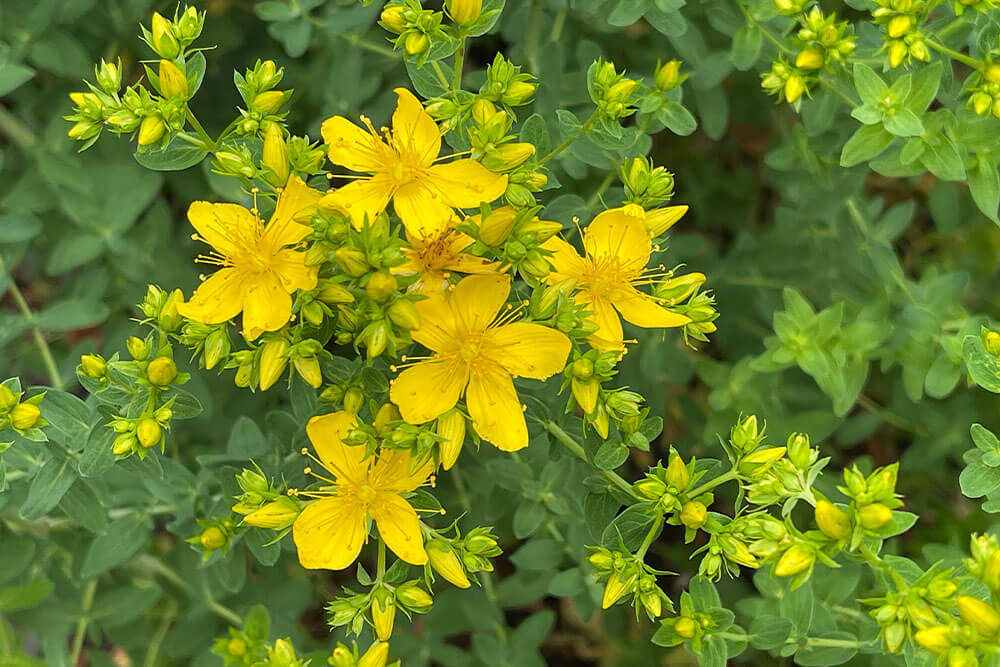
Many people know St. John’s wort as a medicinal plant, but it also makes a lovely, low-maintenance ornamental. Its large, showy flowers bloom from late spring to early fall, and its spreading habit makes a tough yet attractive groundcover. It’s hardy between zones 3 and 8, and grows easily in most garden situations: drought, light shade, and clay are no problem. Neither are deer, since the plant is mildly toxic – but humans are sensitive to the plant as well, and the sap from broken leaves or stems can cause rashes or irritation.
Common St. John’s wort is far from the only garden-ready species in the genus Hypericum: a number of species and varieties are available, including compact perennials, diffuse groundcovers, and even large shrubs. All of them share common St. John’s wort’s resistance to deer, as well as its potential for toxicity, so make sure plants are kept out of the way of curious little creatures, whether four-legged or two.
Frequently Asked Questions About Deer-Resistant Perennials
What flowers do deer hate the most?
This is a hard question to answer without asking the deer — but it would most likely be a flower with a very strong smell, and better yet a flower that has evolved under pressure from deer. Good examples of these would include anise hyssop and many native species of sage, both of which are quite strongly scented both in flowers and leaves.
What is the most deer resistant plant?
There really is no way to answer this question, since there are as many ways of being “deer-resistant” as there are deer-resistant plants. However, it’s safe to say that heavily armed plants — such as some cactuses — are probably near the top, as even hungry deer are physically unable to eat them.
What smells do deer hate?
Deer tend to dislike strong smells, especially the spicy or medicinal smells of plants in the sage family. Strong-smelling plants often contain volatile oils in their leaves, which they produce specifically to make themselves less palatable to herbivores.
Is Echinacea deer resistant?
Yes, but only the flowers are deer-resistant, because they are tough and spiny. Although they’re not among their most preferred plants, deer will still eat young coneflowers that haven’t bloomed.
Are clematis deer resistant?
Unfortunately, no, despite some sources claiming that they resist deer damage. What they are is deer-resilient: because of its lush growth and rapid growth rate, clematis soon recovers from browsing, and is rarely damaged severely — but in areas with large populations, vines should be protected.
Are geraniums deer resistant?
It depends on the species of geranium — but in general, no. Geraniums are not favorites of deer, but they are still browsed, and their small size makes them vulnerable to serious damage from even a single browsing. This is especially true of exotic and annual geraniums. The native hardy geranium (G. macrorrhizum) is probably the most deer-resistant species, which is understandable since it evolved alongside them — but you should not consider your geraniums safe from deer.
